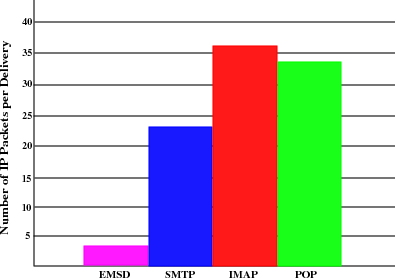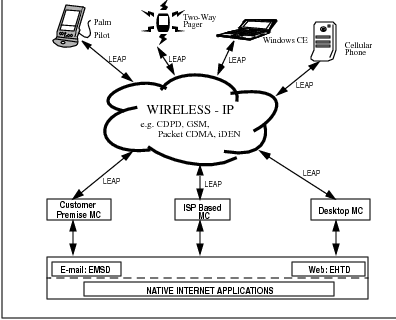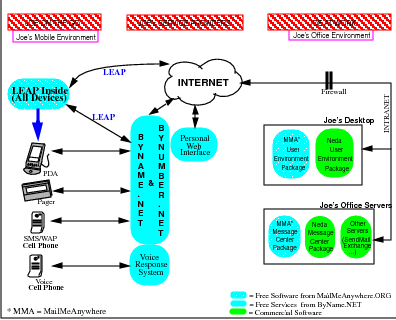Overview of the LEAP Protocols
Overview of the LEAP Protocols
Mohsen Banan
http://mohsen.banan.1.byname.net/ContactMe
First Published: August 4, 2000
Last Updated: August 8, 2000
Copyright ©2000 Mohsen Banan
copies of this manual provided the copyright notice and
this permission notice are preserved on all copies.
A Component of The LEAP Manifesto
This article is one of a series of articles describing various aspects of the Mobile Messaging industry and the Lightweight &
Efficient Application Protocols (LEAP) protocols. For the complete collection of articles see The LEAP Manifesto [5], available
at
http://www.LeapForum.org/LEAP/Manifesto/roadMap/index.html. The LEAP Manifesto is also available at the Free
Protocols Foundation website at
http://www.FreeProtocols.org/LEAP/Manifesto/roadMap/index.html.
Contents
2 The Need for Efficiency
3 Technical Overview of LEAP
3.1 The ESRO Layer: Efficient Transport Services
3.2 The EMSD Layer: Efficient E-Mail
3.3 The EHTD Layer: Efficient Web Browsing
3.4 Other Efficient LEAP Applications
4 Efficiency Characteristics of LEAP
5 LEAP: A Basis for Convergence
6 The End-User’s Experience
7 The LEAP Development Process
7.1 Patent-Freedom
7.2 RFC Publication
7.3 Open Maintenance Organizations
8 LEAPing over WAP
9 A Brief History of LEAP
List of Figures
2 Protocol Efficiency Comparison
3 Open Mobile Messaging
4 The End-User’s Experience
List of Tables
1 Introduction
The key component of the Manifesto is a set of mobile messaging protocols called the Lightweight & Efficient Application Protocols, or LEAP. LEAP is a set of high-performance, efficient protocols which are ideal for mobile and wireless applications. This article provides a brief overview of the LEAP protocols; complete details are provided elsewhere in The LEAP Manifesto [5].
2 The Need for Efficiency
Engineering is the art of making intelligent trade-offs between conflicting requirements. A perennial engineering trade-off is that which must be made between the need for simplicity, and the need for performance. In the case of wireless data communications, performance means such things as data transfer speed, power efficiency, and bandwidth efficiency.
The 1980s and 1990s were the decades of simple protocols - protocols such as the very aptly named Simple Mail Transfer Protocol (SMTP), and Simple Network Management Protocol (SNMP). A great deal of the success of these and other Internet protocols can be attributed to their simplicity.
The first generation of network engineers and network operators were only able to view network communications in relatively simple terms. It was appropriate to cater to that simplicity with simple protocols. A key reason for the success of these early protocols is the lack of technical sophistication on the part of first-generation network engineers and operators.
Simple protocols are easier to make widespread than “good” protocols (meaning those which have better capabilities and performance), for the basic reason that network engineers and operators are able to adopt and implement simple protocols much more easily than “good” protocols.
However, things have changed. Network communications has now expanded into the wireless and mobile data communications arena, and wireless applications demand efficiency. The move to wide-area wireless has significantly shifted the location of the ideal engineering balance between simplicity and performance - moving it away from simplicity, and towards performance.
Wireless networks are constrained by bandwidth limitations, and the hand-held devices they serve are constrained by limitations such as display size, battery capacity, and memory capacity. These constraints place an extremely high premium on the efficiency of data transfer.
Existing Internet protocols do not provide the required efficiency. We therefore need a new generation of high-performance, efficient protocols, to cater to the demands of wireless applications. The point is sometimes made that the need for efficiency in the wireless arena is a temporary one – that advances in wireless engineering technology in the form of third generation (3G) systems will eliminate existing bandwidth limitations, obviating the need for efficient protocols. As long as the capacity of wireless networks remains finite, however, the need for efficiency will persist. Efficient usage is an inherent requirement for any finite resource, therefore the requirement for efficient bandwidth usage and battery longevity will remain.
3 Technical Overview of LEAP
The LEAP protocols are intended to be an enabling catalyst for the growth of the wireless-IP based Mobile Messaging industry, and have been designed with this goal in mind from the outset. They have been designed as a genuine enabling technology which will bring enormous benefits to the industry and the consumer. They are a sound engineering construction based on true openness and patent-freedom.
The LEAP protocols a general-purpose solution to the problem of efficient message transfer, and their use is not limited to any particular device type or network. In particular, LEAP is compatible with all wireless-IP networks. Examples of wireless networks which provide native support for LEAP are CDPD, GSM, packet CDMA, and PCS.
The basic organization of the LEAP protocols is shown in Figure 1.
3.1 The ESRO Layer: Efficient Transport Services
As shown in Figure 1, the LEAP protocols are layered. The lower layer is called Efficient Short Remote Operations, or ESRO. The ESRO layer provides reliable connectionless transport services which can be used for a variety of applications. For example, in addition to mobile messaging services, ESRO can also be used as a transport service for credit card verification applications and efficient micro browsers.
For more information on ESRO see the article ESRO: A Foundation for the Development of Efficient Protocols within The LEAP Manifesto, or visit the ESRO website at http://www.esro.org/.
3.2 The EMSD Layer: Efficient E-Mail
One of the efficient application layers built on top of ESRO is called Efficient Mail Submission & Delivery, or EMSD. EMSD is the component of LEAP that addresses the Mobile Messaging application.
EMSD is a specialized native Internet messaging protocol. It defines a similar set of services to the existing SMTP protocols. It defines a complete set of rules for message submission (end-user device to server) and message delivery (server to end-user device). EMSD meets or exceeds the level of functionality, reliability and security provided by the existing SMTP protocols.
Though its use is not limited to wireless networks, EMSD has been designed specifically to address the requirements of wireless networks, such as CDPD, Wireless-IP, Mobile-IP. In particular, EMSD has been designed with a very strong and clear emphasis on efficiency.
EMSD is highly optimized for the submission and delivery of short (typically 4 kilobytes or less) Internet e-mail messages, and is therefore extremely well suited to the wireless environment. EMSD improves on existing messaging protocols by optimizing the exchange between the server and the end-user device, both in terms of the number of bytes transferred and the number of transmissions. Because of the required timeliness of the messages, mailbox access protocols like POP and IMAP are not used. EMSD is the only truly open messaging protocol that is specifically designed for the wireless network environment.
EMSD is a natural extension of the existing Internet e-mail environment, and accommodates the two-way paging model of usage, in which time-critical messages are ”pushed” to the recipient.
Any network or network operator which faces significant bandwidth and capacity limitations can benefit from the use of EMSD. Any user of a network who must bear high costs for measured network usage can benefit from the use of EMSD.
The initial use of EMSD is expected to be primarily to provide Mobile Messaging services over IP-based wireless networks. However, EMSD can also function as an adjunct to Mail Access Protocols for ”Mail Notification Services.”
For more information on EMSD see the article EMSD: The LEAP E-Mail Component within The LEAP Manifesto, or visit the EMSD website at http://www.emsd.org/.
3.3 The EHTD Layer: Efficient Web Browsing
The Efficient Hyper Text Delivery (EHTD) layer is a hypertext transfer protocol which is optimized for the efficient transfer of short markup pages. EHTD is the component of the LEAP protocols which facilitates web browsing. Along with EMSD, EHTD also benefits from the reliable efficient services of ESRO. A multiplicity of efficient markup languages can be used in conjunction with EHTD. Development of the EHTD protocol is currently in progress.
3.4 Other Efficient LEAP Applications
Various other efficient application protocols are either under development, or anticipated for future development. One of these is the Efficient Dictionary protocol, or E-DICT, which will enable efficient access to dictionaries and other look-up data structures. A starting point for the E-DICT protocol is currently being created. In developing E-DICT, we intend to build on the existing work already done in the context of the DICT protocol.
We anticipate that additional protocols will be needed for a variety of future applications, not all of which can be foreseen at this time. These applications will include such things as efficient implementations of ESRO-based instant messaging, chat, white pages, and others.
4 Efficiency Characteristics of LEAP
All LEAP protocols are designed with efficiency in mind. In this section we describe the efficiency characteristics of EMSD, the LEAP e-mail protocol. Other LEAP protocols deliver similar efficiency benefits.
Most existing Internet e-mail protocols are designed with simplicity, and continuity with SMTP traditions, as two of the primary design requirements. These requirements are in conflict with efficiency of data transfer, and for this reason most existing Internet e-mail protocols are not efficient.
EMSD, on the other hand, has been designed with efficiency as its primary requirement. For this reason, EMSD is a great deal more efficient than existing Internet e-mail protocols.
A detailed efficiency study of the LEAP protocols is provided in the article entitled Efficiency of EMSD [3] within The LEAP Manifesto. That article presents various efficiency studies which compare the efficiency of EMSD to other e-mail protocols such as SMTP, POP and IMAP, and which demonstrate the efficiency advantages of EMSD.
In this section we provide a brief summary of EMSD’s efficiency characteristics. A comparison of the efficiency of the EMSD protocol to other messaging protocols is provided in Figure 2, which shows the delivery traffic overhead for EMSD and three other e-mail protocols: SMTP, IMAP and POP.
As the figure shows, EMSD is much more efficient than SMTP, POP and IMAP. For submission and delivery of short e-mail messages, EMSD is up to five times more efficient than the ubiquitous SMTP e-mail messaging protocols, both in terms of the number of packets transmitted, and in terms of number of bytes transmitted. Even with pipelining and other possible optimizations of SMTP, EMSD remains up to three times more efficient than SMTP, both in terms of the number of packets transmitted, and in terms of number of bytes transmitted.
By minimizing the network traffic required to send and receive messages, EMSD meets the needs of the mobile communicator. The extreme efficiency of the EMSD protocol translates into bandwidth efficiency, which in turn translates into:
- Efficient use of carrier bandwidth, and therefore increased capacity for network operators
- Longer battery life for mobile phones, PDAs and other wireless Internet devices
- Cheaper network usage costs for the end-user
- Reduced latency for the end-user
- Improved support for marginal coverage areas
5 LEAP: A Basis for Convergence
An illustration of how LEAP works is shown in Figure 3. As the figure shows, LEAP provides complete openness of interoperability among Mobile Messaging devices, message centers, and wireless networks.
LEAP will thus have the effect of unifying the entire Mobile Messaging industry under a set of open Internet Protocol (”IP”) standards and protocols so that, in the manner of the World Wide Web, all of the Mobile Messaging networks will effectively operate as one.
In order to achieve this convergence, it is not sufficient for the Mobile Messaging industry merely to adopt a set of common protocols. Many would claim that WAP is in fact just such a set of common protocols. However, a further essential attribute of the required protocols is that they must be a truly integral, “end-to-end” part of the Internet, as opposed to “gateways” which accommodate unnecessary gatekeepers and middlemen.
LEAP is based on the concept of the Internet end-to-end model, in which direct communication between the client and the server assumes that the role of the network service provider is merely that of a pipe – i.e. a passive communication conduit. The Internet end-to-end model assumes that both ends are under the control and choice of the user, and that the servers are widespread, from a variety of providers, and under no specific administration or control. The Internet end-to-end model is in sharp contrast to the traditional phone company and telecommunications approach, which inserts gateways between the two ends, and creates control and exploitation opportunities for the telecommunication operators.
Bearing in mind that the natural convergence of all wireless networks to IP at Layer 3 is well under way and rapidly progressing, the key remaining requirements are: efficiency, lightweightness, miniaturization, and conformance to the Internet end-to-end model. LEAP fulfils all of these requirements. By serving as the necessary missing link, LEAP will become the ultimate basis for convergence.
The mobile e-mail component of LEAP is EMSD. In the spirit of the Internet end-to-end model, the EMSD protocol will facilitate the convergence of the IP-based two-way paging industry, and Internet e-mail, in a natural and transparent manner.
6 The End-User’s Experience
The entire LEAP family of protocols bring efficiency and functionality benefits to the user of miniaturized mobile devices. In this section we describe the user’s experience of an EMSD-enabled device.
Mobile users may not always have the benefit of a wired connection, because of their frequent mobility. They may have a permanent computing system elsewhere, at which they can review large messages at their leisure (for example, messages containing Word documents, Excel spreadsheets, images, etc.). While on the move, however, they need to be kept apprised of important information that requires their immediate attention. Such information cannot wait for them to find the time to set up a laptop and dial in to check for messages. They must be able to accept messages immediately, at any time, and on a device that they can carry anywhere.
The experience of the end-user in using LEAP-based Mobile Messaging technology is illustrated in Figure 4.
The user equips him/herself with an EMSD device. The EMSD device could be a dedicated two-way pager, or a hand-held device (such as a PalmPC) with a wireless (for example CDPD) modem. While the device can be turned off, the modem will remain on at all times to accept incoming messages.
Anyone with access to the Internet can now send a message to this user. The EMSD Service Provider accepts the message from the Internet e-mail system via standard Internet protocols, then delivers the message to the user’s device via EMSD protocols. Since the modem is always on, the message can be accepted at any time, and the user can be notified immediately (in any of the ways commonly used for pager notification) that a message has arrived. The user will then activate the EMSD device and read the message.
To send a message the user enters the message, then submits it to the EMSD Service Provider via the EMSD protocols. The Service Provider then acts like a standard Internet Service Provider and sends the message to its destination.
The end-user device may have a limited display area and a limited keyboard. This is very much the case for today’s cell phones, for example. If so, both the end-user and his/her correspondents may wish to make use of canned messages to facilitate their communication. These canned messages may be defined by the system or end-user device, or they may defined by the message originator as embedded multiple-choice responses.
Figure 4 illustrates how the Mobile Messaging needs of a typical user (we’ll call him Joe) are provided by the LEAP technology. This figure includes all the required technological components, and shows how they interoperate to satisfy Joe’s needs. The figure includes three major components:
- Joe requires some form of handheld mobile device, such as a cell phone or a PDA. This component is shown on the left side of the figure. The device must include the appropriate LEAP device software, allowing it to use the LEAP protocols to communicate with LEAP-enabled Message Centers, either directly over the Internet, or via a Subscriber Service system.
- Joe requires a set of Subscriber Services to support his Mobile Messaging capability. This component is shown in the center of the figure.
- Joe may also wish to have LEAP-based Mobile Messaging capability on a Personal Desktop system at home, or on a Corporate Intranet system at his office. These components are shown on the right side of the figure.
If Joe receives a generic (i.e. non-LEAP) e-mail message over the Internet, then this will be fielded by his Subscriber Service provider, then forwarded to Joe’s mobile device using the LEAP protocols.
Meanwhile, e-mails for Joe may be received in either his home or office mailbox systems. Joe may configure either of these systems to forward certain e-mails to his mobile device on a selective basis. If so, the qualifying e-mails will be forwarded to him directly over the Internet, using the LEAP protocols. The Subscriber Services system need not be involved in the transmission of these forwarded e-mails, since they are being sent from one LEAP-enabled system to another.
In summary, the end-user experience described above represents a superset of the capabilities of the RIM BlackBerry [tm] system. The market success of BlackBerry clearly demonstrates the large user demand for this kind of service. By providing the same functionality of BlackBerry in a completely open fashion, the benefits to the consumer will be that much greater. For further discussion, see the article Operation WhiteBerry in The LEAP Manifesto.
7 The LEAP Development Process
The LEAP protocols are intended to be open in the fullest sense of the word; they are intended to be freely and permanently available, subject to public review and revision, and without usage restrictions of any kind. Therefore the processes and procedures used throughout the development and maintenance of the LEAP protocols have been such as to endow them with these characteristics, and to ensure their integrity as public protocols.
A detailed description of the LEAP development process is provided in the article entitled The LEAP Protocol Development Model within The LEAP Manifesto. In the following sections we provide a brief summary of the major development principles.
7.1 Patent-Freedom
The development and maintenance of the LEAP protocols conforms fully to the policies and procedures of the Free Protocols Foundation. In particular, Neda has declared to the Free Protocols Foundation that the LEAP protocols are patent-free to the best of its knowledge, and that it intends to keep them patent-free permanently. For more information see http://www.FreeProtocols.org.
7.2 RFC Publication
Both protocols have been published as Internet RFCs; ESRO in September 1997 as RFC-2188 [2], and EMSD in March 1999 as RFC-2524 [1]. RFC publication is the mainstream Internet publishing procedure, ensuring that the protocols are freely, easily and permanently accessible to anyone who wishes to use them.
7.3 Open Maintenance Organizations
To provide an open forum for the continued development and maintenance of the LEAP protocols, Neda has established a public organization for each protocol.
The ESRO and EMSD protocols are maintained, respectively, by ESRO.org at http://www.esro.org/, and by EMSD.org at http://www.emsd.org/.
Each of these organizations allows public review of the respective protocol, and provides mechanisms for enhancement of the protocol as a result of collective experience.
Any interested person may participate in the further development of the protocols. Participation in the development process is entirely open and non-exclusive; there are no membership fees.
8 LEAPing over WAP
A set of specifications called the Wireless Application Protocol, or WAP, exists already, and purports to do the same things that LEAP does. However, the WAP specifications are entirely unfit for their claimed purpose, and are doomed to technological and political failure. A detailed criticism of WAP and justification of these statements is provided in an article called The WAP Trap [6] within The LEAP Manifesto.
LEAP is an alternative to WAP, that does in fact what WAP does only in fiction. For a point-by-point comparison of LEAP to WAP, see the article entitled LEAP: One Alternative to WAP [4] within The LEAP Manifesto.
Those characteristics of WAP that make it wholly unfit to be the industry standard are summarized in Table 1, along with the corresponding characteristics of the LEAP protocols.
| WAP | LEAP |
Subject to known patent restrictions | Patent-free |
Self-published by the WAP Forum | Published as Internet RFCs |
Revisions subject to change without notice | All revisions permanently fixed |
Maintained by the WAP Forum | Maintained by open working groups |
Re-invention of existing protocols | Efficiency-optimizing extensions to existing protocols |
Tailored to mobile phone user interface characteristics | User interface independent |
Inherent security vulnerability | Imposes no security assumptions |
Inconsistent protocol number assignment | Consistent protocol number assignment |
Poor technical design | Good technical design |
Initial focus: web browsing | Initial focus: messaging |
Treats wireless as a special case | Treats wireless as an extension of Internet |
9 A Brief History of LEAP
LEAP originated in 1994 as part of the research and development initiatives of McCaw Cellular’s wireless data group (now AT&T Wireless Services). The development work that would eventually lead to LEAP was initially undertaken in the context of the CDPD network; its scope was later expanded to include the Narrowband PCS network also.
By 1996 McCaw Cellular was fully committed to paging, had recently purchased two nationwide narrowband wireless PCS licenses, and wished to develop an efficient wireless message transport and delivery system. Neda Communications, Inc., an independent consulting company working under contract to McCaw Cellular, played a significant role in the development of the required system. Neda Communications had also been involved from the outset in the development of the CDPD specification.
In 1997 however, soon after the purchase of McCaw Cellular by AT&T Wireless, the latter company abandoned the wireless messaging project. Prior to this event, Neda had secured from AT&T the necessary rights to continue independent development of the protocols. Therefore, recognizing the eventual future need for these protocols, Neda then undertook to continue development of them independently of AT&T. They were eventually completed by Neda, published as RFCs, and now form the basis of the LEAP protocols.
Prior to abandoning wireless messaging, AT&T Wireless Services invested several million dollars in related development work. In creating LEAP, therefore, Neda was able to build upon a large abandoned investment by AT&T Wireless.
References
[1] M. Banan. Neda’s Efficient Mail Submission and Delivery (EMSD) Protocol Specification Version 1.3. RFC 2524 (Informational), February 1999.
[2] M. Banan, M. Taylor, and J. Cheng. AT&T/Neda’s Efficient Short Remote Operations (ESRO) Protocol Specification Version 1.2. RFC 2188 (Informational), September 1997.
[3] Mohsen Banan. Efficiency Study of EMSD vs. SMTP/POP3/IMAP. Neda Published Document 103-101-01.01, EMSD Organization, 1996. Online document is available at http://www.emsd.org/pubs/biblio/103-101-01-01/index.html.
[4] Mohsen Banan. LEAP: One Alternative to WAP. A component of LEAP Manifesto 108-102-02, LEAP Forum, Bellevue, WA, February 2000. Online document is available at http://www.freeprotocols.org/pubs/biblio/108-102-02/index.html.
[5] Mohsen Banan. Lightweight & Efficient Application Protocol (LEAP) Manifesto. Technical Report 108-101-01, LEAP Forum, Bellevue, WA, January 2000. Online document is available at http://www.leapforum.org/LEAP/Manifesto/completeManifesto.
[6] Mohsen Banan. The WAP Trap. FPF Published Document 108-102-01, Free Protocols Foundation, Bellevue, WA, January 2000. Online document is available at http://www.freeprotocols.org/wapTrap.









